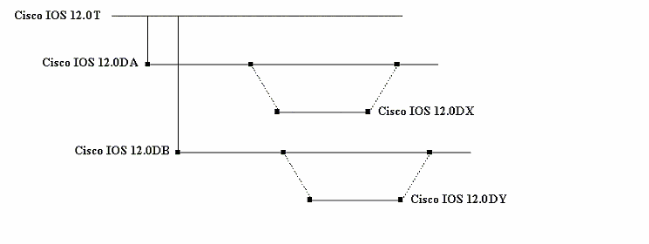Guide to Cisco IOS Release Naming
Available Languages
Contents
Introduction
This document is a guide for the Cisco IOS® Software release naming conventions.
Prerequisites
Requirements
There are no specific requirements for this document.
Components Used
This document is not restricted to specific software and hardware versions.
Conventions
Refer to Cisco Technical Tips Conventions for more information on document conventions.
Letter Definitions for Cisco IOS Release Trains
The first character assigned to the release is based on the technology specific to that release. These are technology characters utilized in Cisco's IOS Release deployment.
-
A = Aggregation/Access Server/Dial technology
-
B = Broadband
-
C = Core routers (11.1CA, 11.1CT, 11.1CC)
-
D = xDSL technology
-
E = Enterprise feature set
-
F = Feature Specific enhancements (11.2F)
-
G = Gigabit Switch Routers (GSR)
-
H = SDH/SONET technology (11.3HA)
-
J = Wireless Networking technology (Aironet)
-
M = Mobile (Restricted to Mobile Wireless BU usage and further reserved for Mainline)
-
N = Voice, Multimedia, Conference (11.3NA)
-
P = Platform features (11.2P)
-
R = Reserved for ROMMON reference
-
S = Service Provider
-
T = Reserved for Consolidated Technology Train
-
W = LAN Switching/Layer 2 routing
-
X = A short lived, one-time release (12.0XA)
-
Y = A short-lived, one-time release (when Xs are exhausted)
-
Z = A short-lived, one-time release (reserved if Ys are exhausted)
Note: New letters may be defined for the purpose of creating new releases.
The first character indicates the technology in the release. For example, an Early Deployment (ED) release based on DSL technology is named Cisco IOS Software Release 12.0DA or 12.0DB. The D in the first position indicates that the release is based on DSL technology. The second character, A or B in this case, is simply the next sequential letter used to differentiate the releases.

The growth of Cisco's target markets has greatly influenced the evolution of the IOS Specific Technology ED (STED) release-naming scheme. This growth has prompted several STEDs to employ the use of two character letters which then have a maintenance number appended. This maintenance trail permits new feature and platform integration with each subsequent maintenance release. The listing of expanded IOS STEDs, their particular technology market, maintenance assignments, and rebuild assignments follow. The usage of the two-character STED designation is restricted to these technologies.
| Technology | Initial Deployment |
|---|---|
| Broadband Cable | 12.2BC |
| LAN Switching | 12.1EA |
| Broadband Cable | 12.1EC |
| Wireless Networking | 12.2JA |
| Mobile Wireless | 12.2MB |
| Mobile Wireless | 12.2MC |
| LAN Switching | 12.0WC |
In most cases, the first character reflects its parent letter followed by a sequential assignment. However, this should not be globally assumed due to the nature of changing technologies and emerging markets.
For example, Cisco IOS Software Releases 12.2MB and 12.2MC are exclusively and solely related to the Mobile Wireless technology and should not be confused with Cisco's Mainline train.
Going forward, the usage of the "M" letter designation will be restricted to avoid potential confusion.
Short-lived Releases Based on an Existing STED Release
For releases with the same platform and similar technology area, the previous nomenclature is used and the release maintenance number is updated. For example, Cisco IOS Software Release 12.2(1)DX and 12.2(2)DX.

Multiple X Releases Based on an Existing STED Release
Special Note on IOS Release Naming Exceptions
Cisco IOS STED Releases 12.1 E and 12.2 B have exhausted the special release naming letter allowances of X, Y, and Z. Therefore, the usage of the letters "V" and "W" have been appended to these releases and should be treated similar to any other "X" Release. For example, Cisco IOS Software Release 12.1(10)EV, Cisco IOS Software Release 12.1(11)EW, and Cisco IOS Software Release 12.2(4)BW.
Release Naming for Cisco IOS X Releases or Short-lived ED Releases based on the T Release
An X followed by a sequential letter indicates short-lived releases. In the example, XA, XB, and XC, the X in the first position indicates a one-time (short-lived) release originating from the major Technology (T) train. The letters in the second position (A, B, C, D, and so on) are sequential letters used to differentiate the releases.
The letter Y is used (YA, YB, YC and so on) when all of the Xs have been exhausted. The letter Z (ZA, ZB, ZC and so on) is reserved for supporting additional short-lived releases as needed for the T release.

The general rules are:
-
To quickly introduce new features on specific platforms or to introduce specific hardware products, the Cisco Business Units can leverage the use of an X release, which is based on the active T release (Cisco IOS Software Release 12.0T).
-
To distinguish different X releases, the second letter is used as a differentiator. The differentiation includes platform and feature support within the release.
-
X releases do not have a scheduled maintenance trail. They live long enough to allow the features/platforms to be integrated into the main line technology T release. In this case, Cisco IOS Software Release 12.0T. A customer in need of bug fixes on an X release is required to upgrade to the next T maintenance release at or after the integration point of the X release.
-
A number appended to the X release (for example, Cisco IOS Software Release 12.0(2)XC1), indicates a rebuild of that release (in this case Cisco IOS Software Release 12.0(2)XC) caused by a catastrophic defect.
Related Information
Contact Cisco
- Open a Support Case

- (Requires a Cisco Service Contract)
 Feedback
Feedback